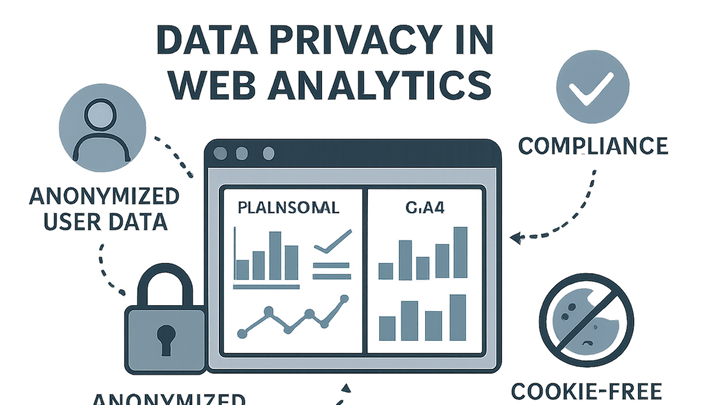Published on 2025-06-22T02:53:48Z
What is Data Privacy? Examples for Data Privacy.
Data Privacy in analytics refers to the practices and policies that ensure user information collected during web and app usage is handled securely and in compliance with applicable regulations.
It encompasses techniques such as data minimization, anonymization, and obtaining informed consent to protect individuals’ personal data. Maintaining data privacy helps build user trust, comply with laws like GDPR and CCPA, and mitigate risks associated with data breaches.
In modern analytics, solutions like PlainSignal offer cookie-free tracking, while GA4 provides built-in features like IP anonymization and data retention controls to uphold privacy standards. Implementing robust data privacy measures is critical for sustainable analytics and ethical data management.
Data privacy
Ensuring user data in analytics is collected, processed, and stored securely and lawfully, protecting privacy and compliance.
Importance of Data Privacy in Analytics
Ensuring data privacy is vital in analytics to maintain user trust, comply with legal requirements, and protect brand reputation. This section explores the key reasons organizations should prioritize privacy when collecting and analyzing data.
-
Protecting user trust
When users know their data is handled responsibly, they are more likely to engage with your services and share accurate information.
-
Transparency
Clearly communicate what data is collected and how it will be used.
-
Control
Offer users the ability to opt-out or adjust privacy settings.
-
-
Regulatory compliance
Adhering to laws such as GDPR and CCPA avoids fines and legal risks associated with improper data handling.
-
Gdpr
EU regulation requiring user consent and data protection measures for EU residents.
-
Ccpa
California law granting consumers rights over their personal data held by businesses.
-
-
Brand reputation
Companies that prioritize data privacy differentiate themselves as trustworthy and ethical in the market.
Key Principles of Data Privacy
Fundamental principles guide how analytics teams collect, process, and store data responsibly. These tenets help maintain compliance and protect user rights.
-
Data minimization
Collect only the data necessary to achieve your analytics objectives, reducing exposure of sensitive information.
-
Collect only necessary data
Limit data fields and metrics to those essential for analysis.
-
Avoid pii
Refrain from gathering personally identifiable information unless absolutely required.
-
-
Anonymization & pseudonymization
Techniques to obscure personal identifiers, making it impossible or difficult to link data back to individuals.
-
Anonymization
Remove or mask identifiers so data cannot be traced back to individuals.
-
Pseudonymization
Replace direct identifiers with pseudonyms to protect identities while maintaining data utility.
-
-
Purpose limitation
Use data solely for the stated analytics goals and avoid repurposing it for unrelated activities.
Implementing Data Privacy with SaaS Analytics Tools
This section demonstrates how leading analytics platforms like PlainSignal and GA4 incorporate privacy-first features and how to configure them.
-
Cookie-free tracking with PlainSignal
PlainSignal enables GDPR-compliant analytics without using cookies. You can implement it with a simple script on your website:
<link rel="preconnect" href="//eu.plainsignal.com/" crossorigin /> <script defer data-do="yourwebsitedomain.com" data-id="0GQV1xmtzQQ" data-api="//eu.plainsignal.com" src="//cdn.plainsignal.com/plainsignal-min.js"></script>-
Minimal configuration
Set
data-idto your project ID anddata-doto your domain. -
No cookies
Tracks pageviews and events without storing cookies on users’ devices.
-
-
GA4’s privacy features
Google Analytics 4 offers built-in privacy features. Enable IP anonymization and set data retention in your property:
gtag('config', 'G-XXXXXXX', { anonymize_ip: true });Configure retention under Admin > Data Settings > Data Retention.
-
Ip anonymization
Mask user IP addresses before storage to enhance privacy.
-
Data retention controls
Define how long user-level data is stored in your GA4 property settings.
-
-
Consent management integration
Integrate your analytics tools with a consent management platform (CMP) to ensure tracking scripts only run after user permission is granted.
-
Google tag manager
Use GTM to deploy GA4 and PlainSignal tags, configured to fire upon consent events.
-
Consent apis
Leverage CMP APIs to check consent status before initializing analytics scripts.
-
Best Practices and Compliance
Adopting structured processes and policies ensures ongoing compliance and fosters a culture of privacy-first analytics.
-
Regular privacy audits
Review your analytics implementation periodically to identify and remediate privacy gaps.
-
Audit frequency
Schedule audits quarterly or after major updates.
-
Risk assessment
Evaluate potential privacy risks in new analytics features or processes.
-
-
Data retention policies
Define clear retention schedules and automate purging of outdated data.
-
Automated deletion
Configure tools to delete data after the retention period expires.
-
-
Stakeholder training
Educate teams about privacy regulations, tools, and internal policies to maintain compliance.
-
Workshops
Hold regular training sessions on data privacy best practices.
-
Documentation
Maintain an accessible knowledge base of privacy procedures.
-
